FIRE HYDRANT
LANDING VALVES
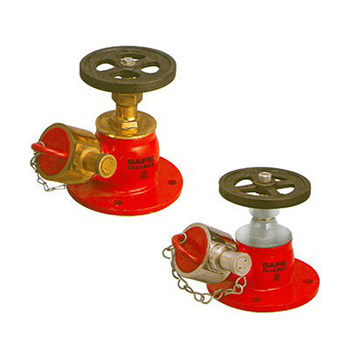
Hydrant landing valves are crucial components of fire hydrant systems, designed to provide a ready means of water supply for firefighting purposes. Here are some key descriptions:
1. Purpose: Hydrant landing valves are installed on the exterior of buildings or in fire hydrant systems to allow firefighters to connect hoses directly to the water supply. They provide a controlled outlet for water to fight fires.
2. Construction: Typically made of durable materials such as brass, these valves are designed to withstand harsh environmental conditions. They often have a weatherproof cap to protect the valve when not in use.
3. Types: There are several types of hydrant landing valves, including oblique valves (angled at 45 degrees), right-angle valves, and straight-through valves, each suitable for different installation requirements.
4. Operation: The valve is opened by turning a handwheel or operating a lever, allowing water to flow through the outlet. Closing the valve stops the flow of water.
5. Connection: Hydrant landing valves are usually designed to connect to standard fire hoses, which can be attached and detached quickly during firefighting operations.
6. Pressure Rating: These valves are designed to withstand high water pressures, ensuring reliable operation during firefighting efforts.
7. Maintenance: Regular inspection and maintenance are crucial to ensure that hydrant landing valves are in proper working condition when needed. This includes checking for leaks, corrosion, and ensuring the valve operates smoothly.
8. Compliance: Hydrant landing valves must comply with relevant standards and regulations to ensure their effectiveness in firefighting operations.
COUPLING & BRANCH NOZZLES
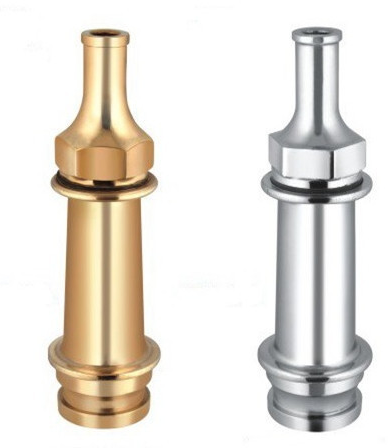
Couplings and branch nozzles are essential components of firefighting equipment, specifically used in fire hose systems. Here’s a description of each:
1. Couplings:
Purpose: Couplings are connectors used to join sections of fire hose together or to connect hoses to hydrants, pumps, or nozzles.
Types: There are two main types of couplings: storz couplings, which are symmetrical and can be connected in any orientation, and threaded couplings, which require a specific orientation to connect.
Materials: Couplings are typically made of aluminum, brass, or stainless steel to withstand high pressures and resist corrosion.
Sizes: Couplings come in various sizes to match the diameter of the fire hose they are intended to connect.
Locking Mechanisms: Some couplings feature locking mechanisms to ensure a secure connection that won’t come loose during firefighting operations.
2. Branch Nozzles:
Purpose: Branch nozzles, also known as fire hose nozzles, are used to control the direction and flow of water from a fire hose.
Types: There are several types of branch nozzles, including fog nozzles, smooth bore nozzles, and adjustable flow nozzles, each designed for specific firefighting applications.
Construction: Branch nozzles are typically made of lightweight yet durable materials such as aluminum or brass. They feature a handle for easy control and adjustment of the water flow.
Flow Control: Branch nozzles allow firefighters to adjust the flow rate and pattern of the water stream, from a wide fog pattern to a concentrated stream.
Compatibility: Branch nozzles are designed to be compatible with standard fire hoses and couplings, allowing for quick and easy connection.
Both couplings and branch nozzles are critical components of firefighting equipment, allowing firefighters to efficiently and effectively deliver water to extinguish fires. Regular inspection, maintenance, and training on the proper use of these components are essential for their effective operation in firefighting scenarios.
HOSE REEL DRUM
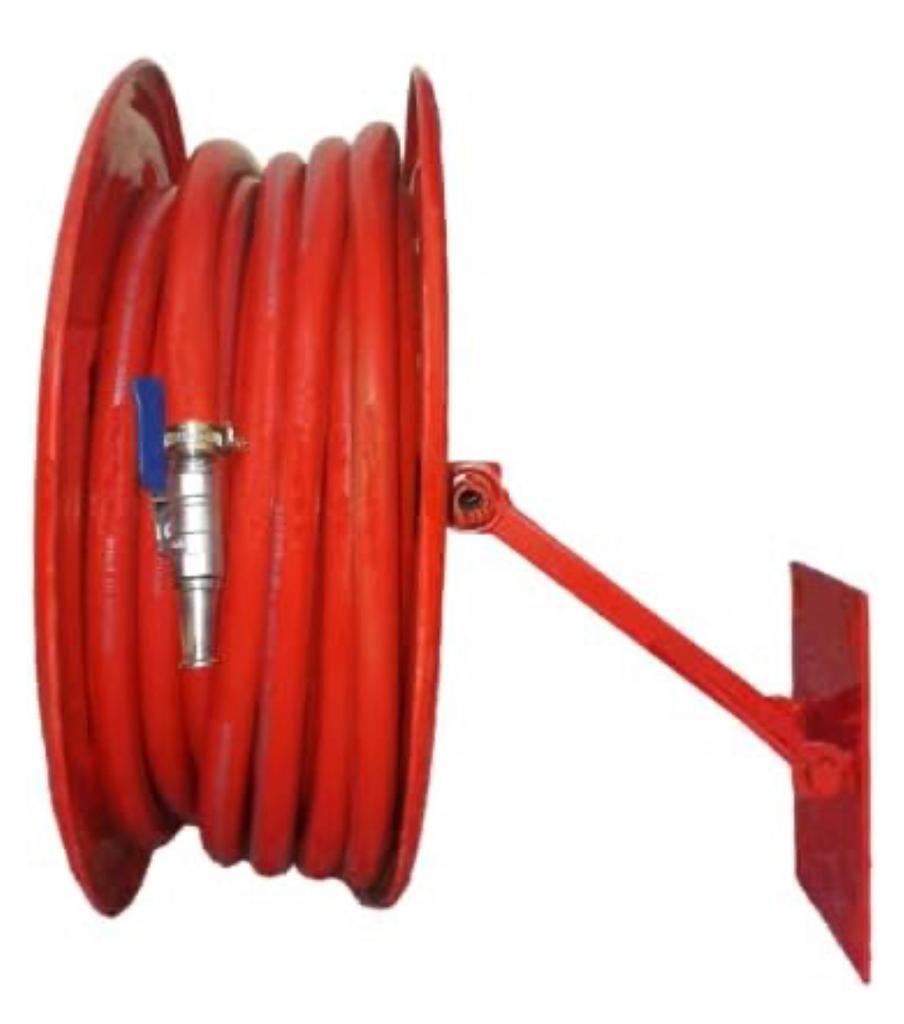
Hose reel drums are devices used to store, deploy, and retract fire hoses in buildings or fire trucks. Here are some key descriptions:
1. Purpose: Hose reel drums are designed to provide a quick and efficient way to access and deploy fire hoses in case of a fire emergency. They are typically installed in buildings, near exits, or in designated fire hose cabinets.
2. Construction: Hose reel drums are usually made of durable materials such as steel, stainless steel, or plastic. They are designed to withstand the rigors of frequent use and exposure to harsh environments.
3. Capacity: The capacity of a hose reel drum refers to the length and diameter of the hose it can accommodate. Common sizes include 30 meters of 19mm diameter hose or 36 meters of 25mm diameter hose.
4. Operation: Hose reel drums are equipped with a crank or handle that allows users to manually deploy or retract the hose. Some models may also feature a spring mechanism that helps to retract the hose automatically after use.
5. Mounting: Hose reel drums can be mounted on walls, ceilings, or on freestanding frames, depending on the installation requirements and available space.
6. Nozzle: A nozzle is attached to the end of the hose on the hose reel drum, allowing firefighters to control the direction and flow of water when extinguishing a fire.
7. Maintenance: Regular maintenance is essential to ensure that hose reel drums are in proper working condition. This includes checking for any damage or leaks in the hose, lubricating moving parts, and ensuring that the reel can be easily deployed and retracted.
8. Compliance: Hose reel drums must comply with relevant standards and regulations, such as those set by the National Fire Protection Association (NFPA), to ensure their effectiveness in fire emergencies.
RRL & THERMOPLAST HOSES
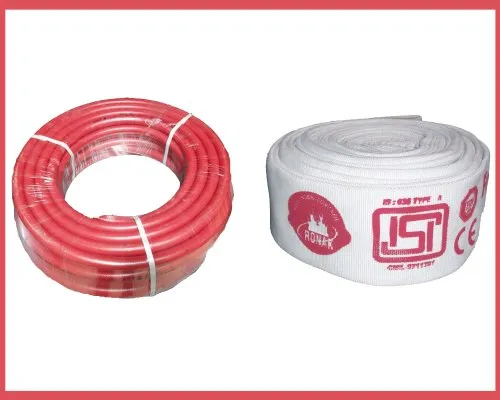
RRL (Reinforced Rubber Lined) and Thermoplastic hoses are two common types of hoses used in firefighting and other applications. Here’s a description of each:
1. RRL (Reinforced Rubber Lined) Hoses:
Construction: RRL hoses consist of a rubber lining reinforced with synthetic yarn or fabric. The reinforcement adds strength to the hose while maintaining flexibility.
Durability: RRL hoses are known for their durability and resistance to abrasion, heat, and chemicals, making them suitable for a wide range of firefighting applications.
Flexibility: The rubber lining and reinforcement allow RRL hoses to remain flexible even in cold weather, making them easy to handle and deploy.
Sizes: RRL hoses come in various sizes and lengths to suit different firefighting needs. Common sizes include 38mm (1.5 inches) and 63mm (2.5 inches) diameter hoses.
Compatibility: RRL hoses are compatible with standard hose fittings and couplings, making them easy to connect to firefighting equipment.
2. Thermoplastic Hoses:
Construction: Thermoplastic hoses are made of synthetic polymers that soften when heated and harden when cooled. They are often reinforced with textile or wire braids for added strength.
Lightweight: Thermoplastic hoses are lightweight compared to RRL hoses, making them easier to handle and deploy in firefighting and other applications.
Flexibility: Thermoplastic hoses are highly flexible, even at low temperatures, allowing them to be easily maneuvered in tight spaces.
Chemical Resistance: Thermoplastic hoses are resistant to a wide range of chemicals, making them suitable for use in hazardous environments.
Sizes: Thermoplastic hoses are available in various sizes and lengths to suit different applications. Common sizes include 25mm (1 inch) and 38mm (1.5 inches) diameter hoses.
Both RRL and thermoplastic hoses are essential components of firefighting equipment, providing a reliable means of delivering water or other extinguishing agents to extinguish fires. The choice between the two types of hoses depends on the specific requirements of the application and the environment in which they will be used.
FIRE SPRINKLERS SYSTEM
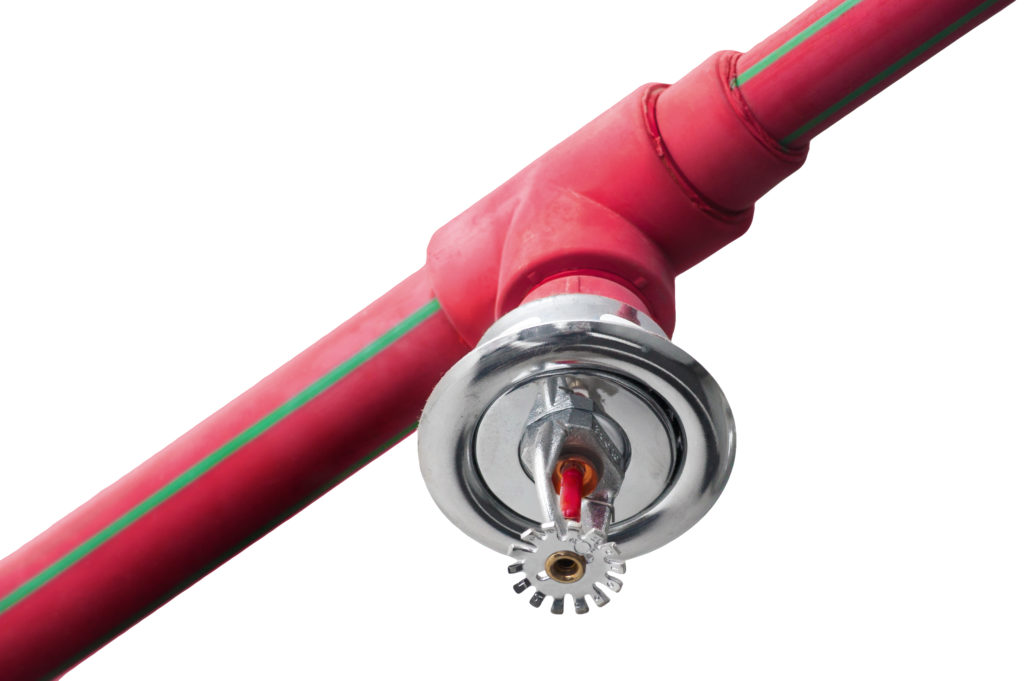
Fire sprinkler systems are active fire protection measures that automatically discharge water or other extinguishing agents when a fire is detected. Here’s a description of the key components and how they work:
1. Piping: Fire sprinkler systems consist of a network of pipes that are installed throughout a building, typically overhead or within the walls. These pipes are connected to a reliable water source, such as a municipal water supply or a dedicated water tank.
2. Sprinkler Heads: Sprinkler heads are the devices that discharge water when a fire is detected. They are attached to the piping and are equipped with a heat-sensitive element, such as a glass bulb or a fusible link, that ruptures when exposed to high temperatures.
3. Water Supply: The water supply for a fire sprinkler system is critical for its effectiveness. It must provide an adequate flow rate and pressure to ensure that there is enough water to suppress a fire.
4. Alarm System: Fire sprinkler systems are often equipped with an alarm system that activates when the sprinklers are triggered. This alerts occupants of the building and notifies the fire department of a potential fire.
5. Control Valve: A control valve is used to control the flow of water to the sprinkler system. It is typically located outside the building and can be manually or automatically operated.
6. Types of Sprinkler Systems:
Wet Pipe System: In a wet pipe system, water is constantly maintained within the piping, ready to be discharged immediately upon activation of a sprinkler head.
Dry Pipe System: In a dry pipe system, the pipes are filled with pressurized air or nitrogen, and water is held back by a valve. When a sprinkler head activates, the valve opens, allowing water to flow into the piping and out of the sprinkler head.
Pre-action System: A pre-action system is similar to a dry pipe system but requires two separate events to activate. First, the detection system must detect a fire, and then the sprinkler head must activate to release water.
Deluge System: In a deluge system, all sprinkler heads are open, and water is constantly flowing through the piping. When a fire is detected, a valve opens, allowing water to flow out of all the sprinkler heads simultaneously.
Fire sprinkler systems are an effective means of fire protection, providing a quick response to fires and helping to minimize damage to property and injuries to occupants. Proper installation, maintenance, and testing are essential to ensure that fire sprinkler systems operate effectively when needed.
